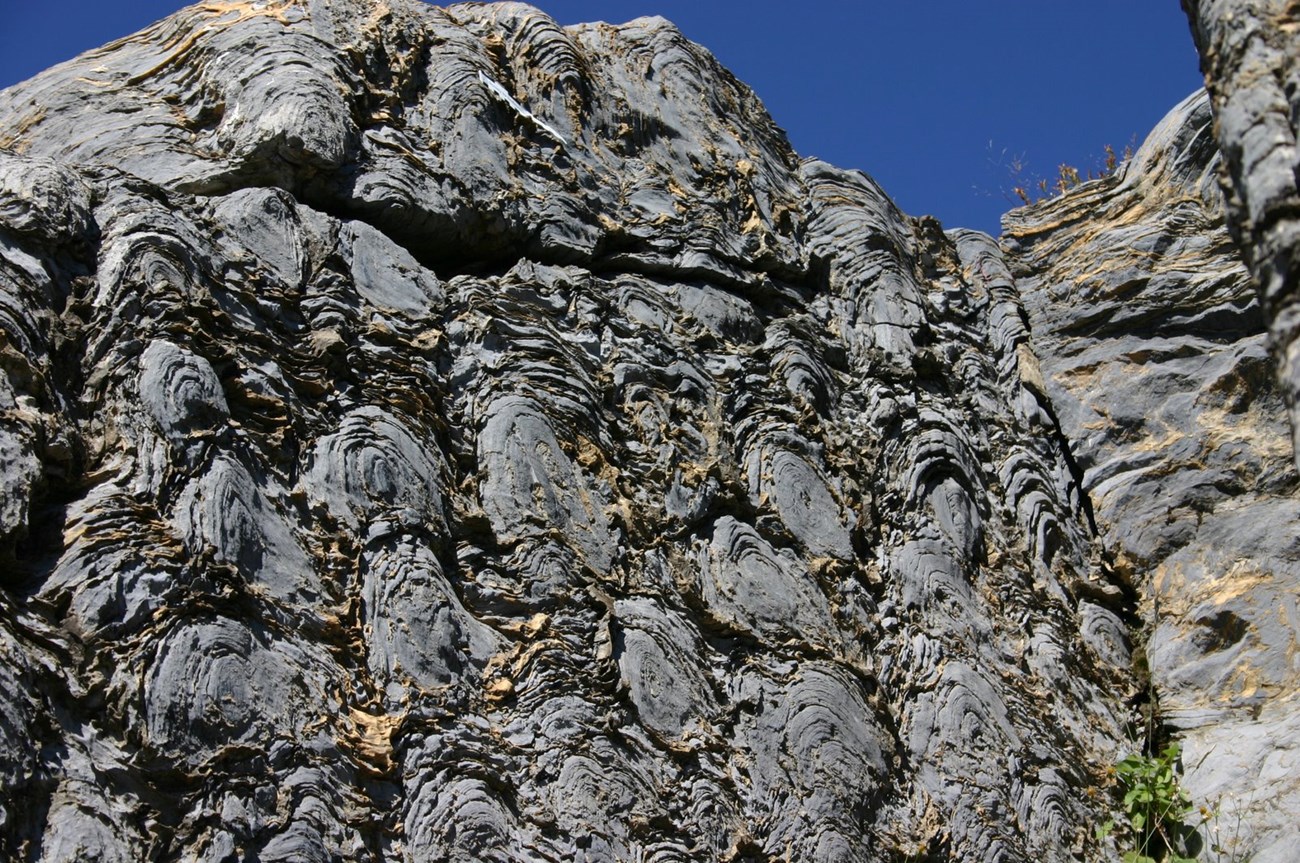Last updated: April 28, 2023
Article
Proterozoic Eon—2.5 Billion to 541 MYA

NPS Image
Introduction
The Proterozoic Eon is the most recent division of the Precambrian. It is also the longest geologic eon, beginning 2.5 billion years ago and ending 541 million years ago. It accounts for a little less than 4/9ths of geologic time. During the Proterozoic Eon, modern plate tectonics became active, and the ancient cores of the continents moved over wide areas of the globe, accumulating smaller fragments of crust and sometimes colliding with other large landmasses. The opposite also happened, leading to continental rifting. North America nearly rifted through what is now its midsection about 1.1 billion years ago. The rocks that formed at this time are best seen around Lake Superior. This rifting appears to have been stopped by the counteracting force of a continental collision on what is now the east coast of the continent. Mountain ranges grew where landmasses collided. Erosion of the mountains provided sediment to nearby basins and shallow seas. Land plants did not yet exist, so wind was much more effective at transporting sediment, and meandering streams were much less common without the support of vegetation. Instead, braided streams were more common. At several times, vast amounts of ice formed, leading to ice ages. Oxygen became an important component of the atmosphere, having been produced by early life as a waste product. Increasing oxygen had profound effects, including the triggering of ice ages, the creation of iron deposits, and the adaptation of some lifeforms to use oxygen, which led to complex multicellular life.
Proterozoic Resources
You can find Proterozoic rocks at more than 60 NPS sites. Most of the rocks are metamorphic rocks such as schist and gneiss, or igneous rocks such as basalt and granite. Sedimentary rocks of this age are frequently metamorphosed, but some are unaltered, particularly upper Proterozoic sandstone and conglomerate. A common type of metamorphosed sedimentary rock of the Proterozoic is quartzite, which began as sandstone. Clusters of parks with Proterozoic rocks are found in several areas (particularly the Mojave Desert, the Great Lakes, and the Blue Ridge and Piedmont regions), but many other parks also have Proterozoic rocks. Grand Canyon National Park, Glacier National Park, and Rocky Mountain National Park are notable examples.
Proterozoic fossils are much more common and diverse than Archean fossils. Stromatolites and other trace fossils of microbes are joined by microfossils, rare body fossils of multicellular organisms, and trace fossils of moving creatures as life diversified. Many forms of life evolved and then went extinct, leaving almost everything about them a complete mystery. The most famous examples are the soft-bodied organisms that made up the “Ediacaran biota”, named after the Ediacara Hills, an area in southern Australia where these organisms flourished between about 560 and 550 million years ago. The oldest fossils in National Park Service areas are from the middle Proterozoic (Mesoproterozoic) and consist of microfossils, small macroscopic body fossils, and microbial structures from Glacier National Park, providing evidence of life from between about 1.5 and 1.4 billion years ago. Younger Mesoproterozoic fossils have been found at Grand Canyon National Park and Tonto National Monument. The stromatolites of Glacier National Park are some of the best-known examples of these fossils. Younger Proterozoic (Neoproterozoic) fossils have been found at a half-dozen parks, including Appalachian National Scenic Trail, Boston Harbor Islands National Recreation Area, Death Valley National Park, Grand Canyon National Park, Mojave National Preserve, and Yukon–Charley Rivers National Preserve. It was once thought that there might be fossils in the lower Proterozoic (Paleoproterozoic) Sioux Quartzite at or near Pipestone National Monument, but the objects are now known to be pseudofossils, inorganic objects that have been mistaken for fossils.
Visit—Proterozoic Parks
Every park contains some slice of geologic time. Below, we highlight selected parks associated with the Proterozoic. This is not to say that a particular park has only rocks from the specified period. Rather, rocks in selected parks exemplify a certain event or preserve fossils or rocks from a certain geologic age.
-
Appalachian National Scenic Trail (APPA), CT, GA, MA, MD, ME, NC, NH, NJ, NY, PA, TN, VA, VT, and WV—[APPA Geodiversity Atlas] [APPA Park Home] [APPA npshistory.com]
-
Boston Harbor Islands National Recreation Area (BOHA), Maine—[BOHA Geodiversity Atlas] [BOHA Park Home] [BOHA npshistory.com]
-
Death Valley National Park (DEVA), California & Nevada—[DEVA Geodiversity Atlas] [DEVA Park Home] [DEVA npshistory.com]
-
Glacier National Park (GLAC), Montana—[GLAC Geodiversity Atlas] [GLAC Park Home] [GLAC npshistory.com]
-
Grand Canyon National Park (GRCA), Arizona—[GRCA Geodiversity Atlas] [GRCA Park Home] [GRCA npshistory.com]
-
Mojave National Preserve (MOJA), California—[MOJA Geodiversity Atlas] [MOJA Park Home] [MOJA npshistory.com]
-
Pipestone National Monument (PIPE), Minnesota—[PIPE Geodiversity Atlas] [PIPE Park Home] [PIPE npshistory.com]
-
Tonto National Monument (TONT), Arizona—[TONT Geodiversity Atlas] [TONT Park Home] [TONT npshistory.com]
-
Yukon-Charley Rivers National Preserve (YUCH), Alaska—[YUCH Geodiversity Atlas] [YUCH Park Home] [YUCH npshistory.com]
More about the Precambrian
►
Tags
- appalachian national scenic trail
- boston harbor islands national recreation area
- death valley national park
- glacier national park
- grand canyon national park
- mojave national preserve
- pipestone national monument
- tonto national monument
- yukon - charley rivers national preserve
- fossils
- paleontology
- geology
- geologic time

